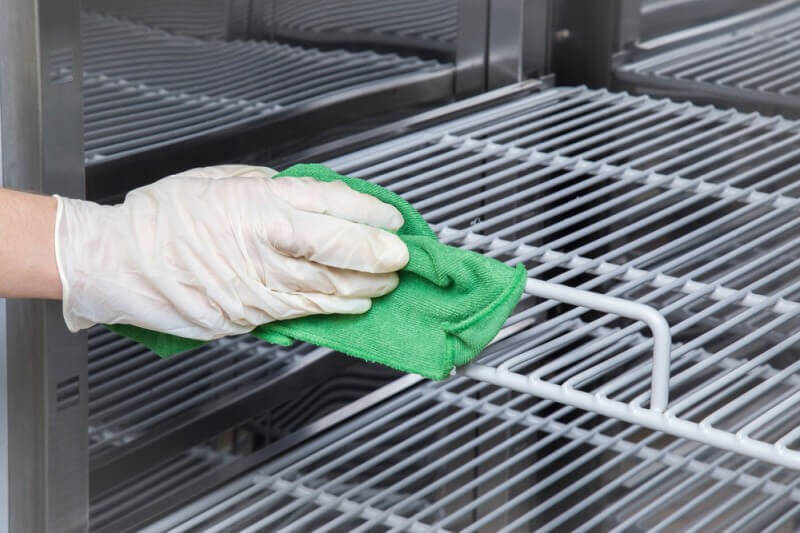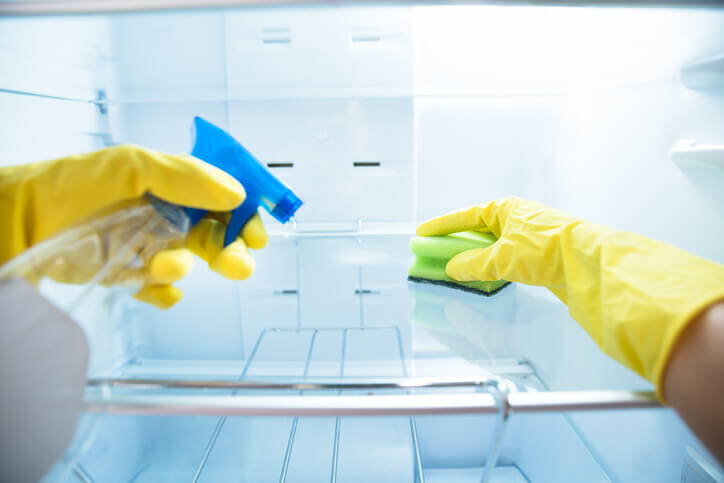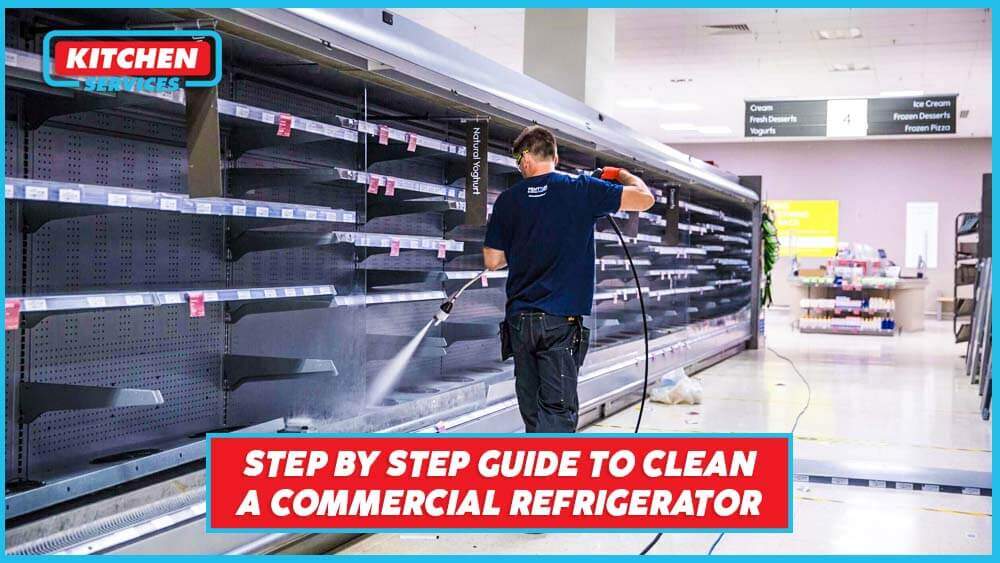So, you’ve just made a significant investment in a commercial refrigerator or freezer for your business. Congratulations on your achievement! We hope that your new refrigerator or freezer will offer you and your customers years of dependable service. But that doesn’t happen unless you give your refrigerator the care and attention it requires in a busy kitchen. By following this Guide to Clean a Commercial Refrigerator you can extend its lifespan.
For both your business and your staff, the cleanliness of any commercial equipment should be a top priority. Although it can be time-consuming, there are numerous reasons why professional cleaning equipment such as refrigerators should be scheduled during working hours.
Before looking at those reasons, we have come up with a step by step actionable guide on commercial refrigerator cleaning. If followed religiously, this simple and effective guide has the ability to extend the lifespan of your refrigeration unit.
Steps to Clean Your Commercial Refrigerator
Before you begin proper cleaning, make sure to re-organize the fridge. Start by emptying it, throwing away the expired stuff, and sanitizing everything. Here’s a step-by-step guide on cleaning your refrigerator.
Unplug Units of your Refrigerator
- First things first, you need to unplug all your refrigeration units in order to eliminate the chances of electrocution.
- This will save you lots of energy during your cleaning session.
- All you have to do is turn off the main switch that provides your unit with the current.
- Then carefully remove the plug from the slot.
- This will also help in accumulated ice to melt quickly.

Empty each shelf of all items
- After successfully unplugging the unit, your next step is to one by one empty each shelf.
- Start by removing the small items placed in the front.
- Then come to the bigger ones placed at the back.
- Make sure to place these items in a backup refrigeration unit meanwhile.
- The biggest mistake people make while performing this step is putting things on the sides instead of completing taking them out, for getting done quickly. However, this is dangerous as there is a big chance you’ll leave contaminated or moldy stains at the corners.
Discard all the Moldy and Expired Food present
- Your next step should be to inspect the condition of the things you took out of your unit.
- It is possible for food items to get mixed. So look for the expiry date and throw away the expired items.
- In case, there is no expiry date mentioned, you can smell it and get an idea.
- In commercial refrigeration units, it is always a good idea to throw away already opened canned food items.
Furthermore, while you want to save money wherever you can, storing already-opened cans and jars after they’ve been used isn’t a good idea. Because we know you wouldn’t want to save money at the expense of your customer’s health. Even if the expiry date isn’t close, once you have opened the seal, the item should be consumed quickly. Similarly, get rid of anything you haven’t used in months and don’t intend to use anytime soon.

Wipe Off the Interior of your Commercial Refrigerator
- In order to perform this part, your first step should be to get a bucket full of warm water mixed with a mild soapy detergent.
- Get a good quality sponge. It is good to use highly absorbent microfibre towels as they are good with tough dirt accumulation.
- Try using a soft-bristled brush for smaller areas and corners of your unit.
- Dip it in the detergent and gently rub it into the inaccessible areas.
- Once you are done with a thorough scrubbing of the interior of your unit, rinse it with clean water.

Disinfect the Interior
- It is not easy to make stubborn bacteria go away. Hence, after cleaning the unit with soapy water, you should go the extra mile to disinfect it.
- Buy a good food disinfectant and apply it gently on the surfaces.
- Make sure to apply just a little amount of the disinfectant.
Cleaning of Exterior
- By now you have thoroughly cleaned the inside of your unit and made it bacteria free. Now is the time to pay some attention to the exterior.
- When you don’t clean the outside of the refrigerator, dust and other material might obstruct the mechanical and cooling functions of the unit.
- Take a duster and gently wipe off the exterior of your commercial refrigerator.
- Then move towards the backside of your unit, you will see the condenser coils at the bottom.
- Get a vacuum hose to clear out the dirt from condenser coils.
- Next, clean and empty the drainage pan that is present near the bottom of the refrigerator. This will prevent all your moisture problems.
Restock All the Food Items
- Now that your refrigerator is clean, it’s time to put everything back in its place – in a neat and tidy manner.
- The way you load and organize products inside impacts how efficiently you use stock while also preventing problems that can lead to bacteria and mold growth.
Follow our guide on how to organize your commercial freezer/refrigerator for proper organizing tips.
How to disinfect refrigerator from coronavirus?
I think is the best time to do some serious spring cleaning like you never did before in your commercial kitchen. Your refrigerator might be the perfect place to start, after bringing home all those groceries which may have had germs on their packaging. Before you stock up the latest round of groceries in your refrigerator, you must take a few minutes to disinfect all the items in this era of pandemics.
Dr. Warner Greene, who is a leading virologist and research scientist with the Gladstone Institutes in San Francisco has some great ideas for your refrigerator’s disinfection that is “Coronaviruses are, by their nature, ‘sticky’ viruses,” Dr. Greene said. “They can survive for a surprising period of time on surfaces, although they are rapidly dying on these surfaces.”
So here are the quick tips that you may follow in order to disinfect your refrigerator from coronavirus.
Disinfecting Your Fridge
In order to disinfect your fridge from coronavirus, you must have to prepare a bowl or even a bucket of disinfectant, preferably with an alcohol base. There are actually two things that can dissolve the germs of the coronavirus disease. You can either use alcohol for this purpose, or a mixture of soap and water will also help. You can also create your own with diluted household bleach by combining 1/3 cup of bleach with a gallon of water. If not that you can also add some soap to warm water.
Here are some steps you need to follow in order to disinfect your refrigerator from coronavirus.
Step1:
First of all, you need to clear out all the items that are there in your fridge. Never let them sit out for more than a couple of hours. To clean those items you need to use the disinfectant that you made or even hot soapy water in order to clean the packaging of the food and drinks. After cleaning you may return the items to a new and clean surface.
Step 2:
After these items, you will have to remove shelves, drawers, and all other removable parts from the fridge. But you will have to be extra careful that you do not run cold glass shelves in hot water otherwise there are high chances that they may crack so let them come to room temperature first. Wash all these shelves and parts again with hot soapy water and dry with a clean towel.
Step 3:
After that, you will have to clean the inside of the fridge with disinfectant or hot soapy water. But make sure to get in all the nooks and crannies.
Step 4:
You can also mix a solution of 1 TBSP bleach with 1 gallon of water and put this in a spray bottle and spray to clean further.
Step 5:
After the cleaning and disinfecting are done you may return the shelves and clean food to your clean fridge, free from any possible coronavirus germs. Also, make sure that you do not forget to clean the counter where the dirty items were touching and also to wash any towels that were used for cleaning and disinfecting. Also, wash your hands when you are done.
Additional Step
It would also be a great idea if you replace your refrigerator water filters meanwhile. Many of us forget and never change things. Or, better yet, order a bypass plug for the filter and instead plumb your Body Glove filter to your fridge. Then, you will have superior quality ice and water from the convenience of your fridge.
Ozone Water for Cleaning
Additionally, ozone water can prove to be an incredible tool in order to sanitize and help in your spring cleaning. Ozone water helps in Killing any Coronavirus germs that might be there in your refrigerator.
How to clean a refrigerator with Vinegar?
Do you even remember when was the last time you deep cleaned your refrigerator? Well, you can clean and disinfect both the exterior and interior of your refrigerator pretty quickly with the help of white vinegar and a little elbow grease.
Read on and follow the steps to get your refrigerator sparkling clean.
Method 1
Cleaning the Exterior
You can mix equal parts vinegar and water and put them in a spray bottle. White vinegar has proved to be an excellent and effective cleaning agent because of the reason that it kills germs, cuts through grime, and helps in destroying all sorts of odors. You must already have some of it in your pantry. On the other hand, you can also make the mixture in any bowl or cup and directly apply it with a piece of cloth. If you combine equal parts apple cider vinegar and water it will also work very well.
Spray the mixture on all exterior sides of the fridge.
In case you are using any spray bottle, all you have to do is just spray it directly with 1 or 2 showers. If you have a cleaning cloth, you can moisten the cloth with some drops of the solution or until it is fully dampened before you apply the cloth to the fridge. Do not forget the top of the fridge in case you want to be really thorough.
Wait 10-15 minutes and wipe the surfaces with a clean cloth.
After you are finished with the wiping of the flat surfaces, make sure to get the door handles, edges, seals, and other crevices clean as well. If you observe that the surface is not properly cleaned after a single application, you can again repeat the same process until the grease is gone. In case your fridge is stainless steel, never forget to wipe in the direction of the stainless steel’s grain.
In the case of stainless-steel fridges, you can also try to polish the surface after wiping down the vinegar solution by adding 2-3 drops of olive oil to your microfiber cloth, and then you can buff in the direction of the grain. You can do this once a week or as per your need.
Method 2: Disinfecting the Inside
Take out the shelves, drawers, and racks.
For this step, you may take all of your food out and move it to a cooler and safer place so that you can have the access to the whole interior. This would also safeguard your food from getting spoiled while you clean. You do not have to unplug your fridge for this.
Spray the surfaces generously with a vinegar-water solution.
Again for this step you have to mix equal parts vinegar and water in any spray bottle. Apply this solution to the fridge interior. Wait a few minutes so the vinegar can cut through any grime.
Wipe down the interior with a clean rag or towel.
You can use any soft toothbrush so that you can clean inside any hard-to-reach nooks and crannies. Repeat the process as many times as you need to get rid of stubborn grime.
Place a bowl of vinegar inside the fridge if you need to remove odors.
In order to neutralize any lingering smells, you can fill a glass or bowl halfway with white vinegar and stick it on a stable shelf in your fridge where it does not get knocked over. You can also replace the vinegar every few days until the smell is gone completely.
Method 3: Handling the Freezer
Spray the inside of the freezer liberally with a vinegar-water solution.
For this step, you can combine equal parts hot water and vinegar and transfer the solution to a spray bottle. Coat the top, bottom, and sides of your refrigerator’s interior with this mixture. Do not forget the inside of the door and any nooks and crannies.
Wipe down the inside thoroughly with a cloth or towel.
In case of any stubborn spots, you can let the vinegar solution sit on the surface for 10 minutes before you wipe it away. Repeat this step as needed until the interior is nice and clean.
Put the shelves, drawers, and food back into your freezer.
After the inside of the refrigerator is dry, put any removable parts back into place. Plugin the appliance and let the freezer get cold. Then, put the food items back, and voila you have a clean, shiny refrigerator on the go.
Follow our temperature guidelines for commercial freezer for proper working of your Walk in freezer
Why should you clean your commercial refrigerator?
With so much opening and closing, retrieval, and restocking, it’s easy to overlook spills and stains, or even see them, in the thick of the service rush. Since products are frequently shifted, some of the less popular materials and stock are left unfinished or unused by the time they expire.
Cross-contamination and bad odors can emerge from residue and deterioration, affecting food storage and, as a result, quality and freshness. Worse, when these less-than-delicious distinctive flavors are provided, they can cause customer dissatisfaction and shake the foundations of trust between you and your customers. When it comes to health inspections, you could face anything from a few citations to an order to close your business.
Hence it is extremely important to religiously carry out the cleaning of your commercial refrigeration unit.

